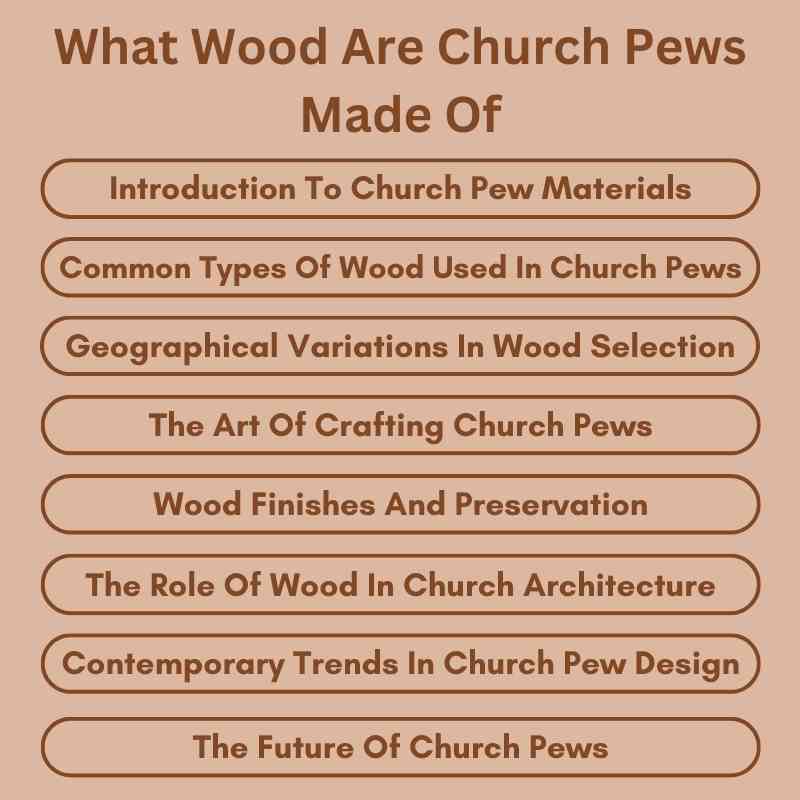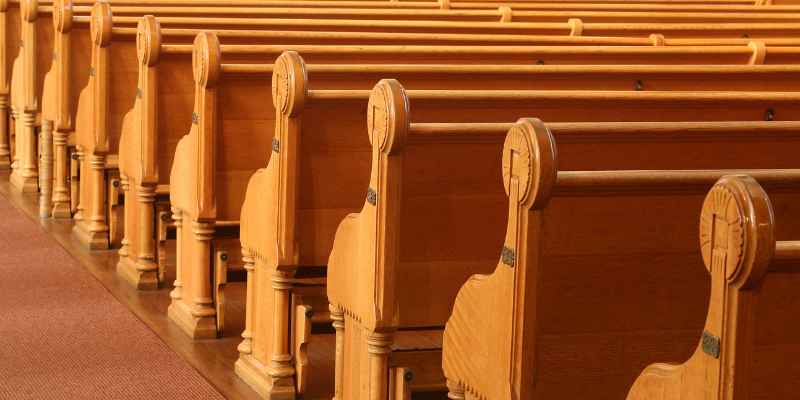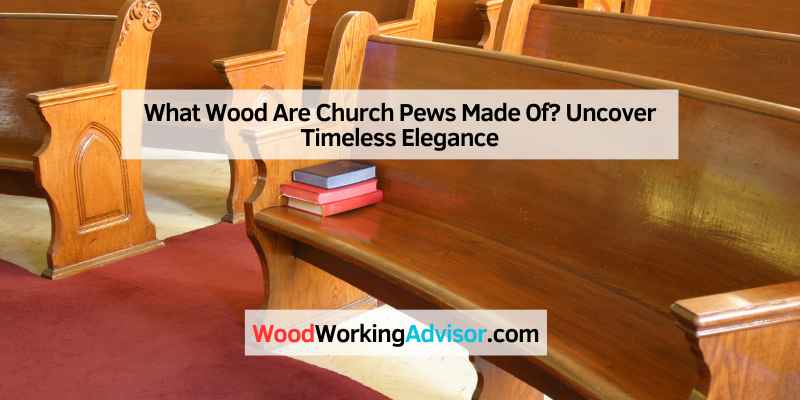Church pews are typically made from hardwoods like oak, maple, or cherry. These materials provide durability and an aesthetic appeal.
Church pews serve as a significant element in worship spaces, offering comfort and community. The choice of wood for these benches reflects the church’s values and traditions. Hardwoods are favored for their strength and longevity, ensuring that pews withstand years of use.
Oak is popular for its rich grain and sturdy nature, while maple offers a lighter hue and smooth finish. Cherry wood adds warmth and elegance, enhancing the overall ambiance. The craftsmanship involved in creating pews also showcases the artistry of woodworkers, making each piece unique. Understanding the materials helps appreciate the beauty and significance of church furnishings.
Introduction To Church Pew Materials
The material of church pews greatly influences the atmosphere of a place of worship. Wood is a common choice due to its warmth and beauty. Different types of wood evoke various feelings and traditions.
Using wood in religious settings symbolizes strength and stability. It connects the physical space to the spiritual experience. People often feel more at ease in wooden surroundings.
| Type of Wood | Characteristics |
|---|---|
| Oak | Durable and classic |
| Maple | Light color and smooth grain |
| Cherry | Rich color that deepens over time |
Understanding the history of church pews reveals their importance in community life. Initially, pews were simple benches. Over time, they became more ornate and comfortable.
Many churches still use traditional wood styles. Each type of wood tells a story. This connects worshippers to their heritage and faith.

Common Types Of Wood Used In Church Pews
Oak is a popular choice for church pews. It symbolizes strength and durability. This wood can last for many years.
Pine is known for being affordable and abundant. It is lighter and easy to work with.
Mahogany offers a sense of richness and elegance. Its deep color adds beauty to any setting.
Cherry wood brings warmth and a fine texture. It ages beautifully and develops a lovely patina.
Geographical Variations In Wood Selection
Different regions choose unique woods for church pews. Europeans often prefer oak and walnut. These woods are strong and beautiful.
In America, pine and cherry are popular choices. Pine is affordable and easy to work with. Cherry adds a rich color and smooth finish.
Tropical regions favor mahogany and teak. Mahogany is prized for its durability and deep hue. Teak is known for its water resistance and strength.
The Art Of Crafting Church Pews
The crafting of church pews involves various materials. Commonly, pews are made from oak, maple, or pine. Each wood type has unique characteristics. Oak offers strength and durability, while maple adds a smooth finish. Pine is often more affordable and lightweight.
Traditional joinery techniques include methods like dovetail and mortise-and-tenon joints. These techniques ensure strong connections between wood pieces. Craftsmen focus on precision and skill to create beautiful, lasting pews.
Modern manufacturing methods use advanced tools and machinery. Techniques like CNC machining allow for exact cuts and designs. This process can increase production speed while maintaining quality. Many pews now combine traditional craftsmanship with modern efficiency.
Wood Finishes And Preservation
Choosing the right finish for church pews is essential. It impacts both the look and durability. Popular finishes include oil, varnish, and lacquer. Each has unique qualities that affect appearance and protection.
Regular maintenance keeps pews looking great. Dust them often with a soft cloth. Use a gentle cleaner to remove stains. Avoid harsh chemicals that can damage the finish. Reseal the wood every few years for added protection.
Proper care ensures longevity. Keep pews away from direct sunlight. This prevents fading and warping. Maintaining a stable humidity level also helps preserve the wood.
The Role Of Wood In Church Architecture
The choice of wood in church architecture greatly influences its aesthetic and feel. Common woods include oak, maple, and pine. Each type adds unique warmth and character to the space.
Harmony between pews and the overall design creates a welcoming atmosphere. Natural wood tones complement stained glass and stone elements. This connection fosters a sense of peace and community.
Church pews often feature intricate carvings and designs. These details enhance the spiritual experience. The comfort of the wood also encourages longer gatherings.
Contemporary Trends In Church Pew Design
Church pews are evolving to reflect modern trends. Many designs now use metal, glass, and composite materials. These materials offer durability and a fresh look.
Wood remains popular but is often combined with other elements. This blend creates a balance of tradition and innovation. Churches can maintain their heritage while embracing new styles.
Customization is key in contemporary pew design. Many places offer personalized options to fit unique aesthetics. This approach allows churches to express their identity while ensuring comfort.
The Future Of Church Pews
Church pews are evolving to meet modern needs. Sustainability is becoming key in material choice. Many churches now prefer reclaimed wood. This helps reduce waste and is eco-friendly.
New pew designs often use bamboo and composite materials. These options are durable and stylish. They also support local craftsmanship and economies.
Changing worship practices affect pew designs. Flexible seating arrangements are now popular. This allows for easier movement during services. Comfort and accessibility are top priorities for many congregations.
Churches are also considering the lifecycle of materials. Choosing long-lasting options reduces future costs and environmental impact. Sustainable practices will shape the future of church pews.

Frequently Asked Questions
What Types Of Wood Are Commonly Used For Church Pews?
Church pews are often made from hardwoods like oak, maple, and cherry. These woods are chosen for their durability and aesthetic appeal. Oak is particularly popular due to its strength and classic look. Other options include walnut and birch, which also provide unique finishes.
Why Is Hardwood Preferred For Church Pews?
Hardwood is preferred for church pews due to its longevity and resistance to wear. It can withstand heavy use while maintaining its appearance. Additionally, hardwood can be easily polished and refinished, ensuring pews remain attractive over time. This makes it a practical and beautiful choice for religious settings.
How Do Church Pew Materials Affect Comfort?
The material of church pews significantly impacts comfort. Hardwoods provide a sturdy seating option but can be hard over long periods. Many churches enhance comfort with cushions or padding. This combination balances durability and comfort, allowing congregants to focus on worship without discomfort.
Can Church Pews Be Customized In Terms Of Wood Type?
Yes, church pews can be customized in terms of wood type. Many manufacturers offer a selection of woods to match the church’s aesthetic. Customization allows for unique designs that reflect the church’s character. This ensures that the pews fit harmoniously within the worship space.
Conclusion
Choosing the right wood for church pews enhances both aesthetics and durability. Popular options like oak, pine, and cherry each bring unique qualities. Understanding these materials helps in making informed decisions for any church setting. Ultimately, the choice of wood reflects the values and traditions of the congregation.

